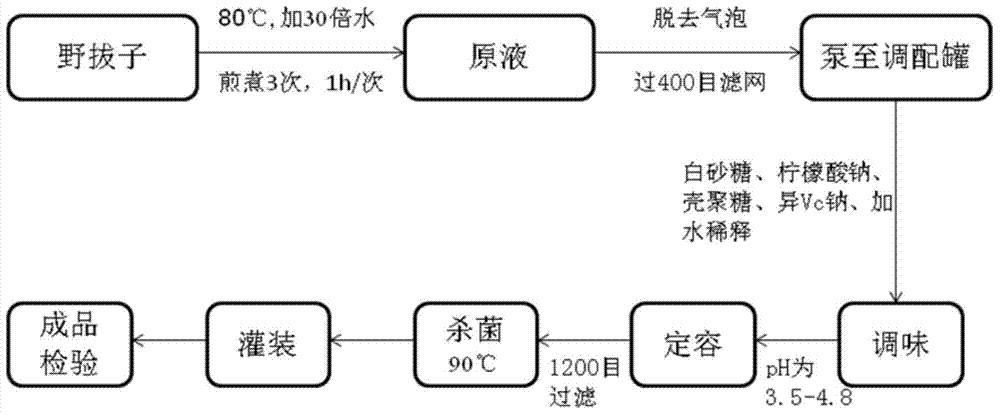Elsholtzia rugulosa drink and preparation technology thereof
A preparation process and a technology of wild thorn, which is applied in the field of food processing, can solve the problems of unreasonable raw material compatibility, extensive production method, uncontrollable quality, etc., and achieve the effect of simple production method, controllable product quality and good clarity.
- Summary
- Abstract
- Description
- Claims
- Application Information
AI Technical Summary
Problems solved by technology
Method used
Image
Examples
preparation example Construction
[0033] The preparation technology of above-mentioned wild berries beverage comprises the following steps:
[0034] 1) Decoction: first dry and crush the seeds of Rhizoma praecox to 10 meshes, weigh 2.0kg~4.0kg of dried and crushed seeds of Rhizoma praecox, soak in water for 15~30min, then decoct in a constant temperature water bath at 80°C for 0.5~1.5h, Filter, retain the filtrate, extract the filter residue again, continuously extract 3 times, and combine the filtrate;
[0035] 2) Flocculation: Add 0.05kg-0.15kg chitosan and 0.1kg-0.4kg sodium citrate to the filtrate, let it stand at 30°C for 0.5h, pass through a 400-mesh filter to obtain a clarified liquid;
[0036] 3) Seasoning: add 0.02kg-0.2kg sodium erythorbate and 1.0kg-5.0kg white granulated sugar to the clarified liquid, and adjust the volume to 1000L with water to obtain the wild berry drink;
[0037] 4) Sterilization, filling, finished product inspection.
[0038] In the preparation process of the above-mentioned ...
Embodiment 1
[0043] Example 1 Optimization of decocting process of Semen praecox
[0044] 1. Experimental plan: use the orthogonal test design, adopt the traditional water extraction method (decoction method), investigate the ratio of material to liquid (mass of wild berries / volume of water), decoction time, decoction temperature and decoction times four Factors, taking the percentage of rutin in the decoction of wild rhizome as the index. The factor levels are shown in Table 1.
[0045] Table 1 Factor and level table
[0046]
[0047] According to factor level Table 1, using L 9 (3 4 ) Orthogonal experimental design table for experiments, as shown in Table 2.
[0048] Table 2 Orthogonal experiment design table
[0049] Number of experimental groups
A Ratio of material to liquid
B cooking time
C cooking temperature
D decoction times
1
1
1
1
1
2
1
2
2
2
3
1
3
3
3
4
2
1
2 ...
Embodiment 2
[0072] Example 2 The impact of chitosan on the clarification of the wild berry beverage (clarity is controllable)
[0073] Determination of clarity: take distilled water as a blank to measure the light transmittance at 510nm wavelength, and use T% to express its clarity.
[0074] Determination of rutin content: refer to the determination under "Determination of total flavonoids".
[0075] Chitosan clarification experiment: the test solution of Rhizoma chinensis was clarified with 1% chitosan, and the effects of chitosan dosage, action time and temperature were investigated by single factor experiment.
[0076] 1. Effect of different chitosan dosages on clarity and active ingredient content
[0077] Take 100mL of the mixed solution of Rhizoma chinensis, add 1% chitosan of different volumes respectively, shake well, let it stand at room temperature for 30min, filter, measure the light transmittance (T%) at 510nm and determine the content of rutin.
[0078] Table 5 Effects of d...
PUM
 Login to View More
Login to View More Abstract
Description
Claims
Application Information
 Login to View More
Login to View More - R&D Engineer
- R&D Manager
- IP Professional
- Industry Leading Data Capabilities
- Powerful AI technology
- Patent DNA Extraction
Browse by: Latest US Patents, China's latest patents, Technical Efficacy Thesaurus, Application Domain, Technology Topic, Popular Technical Reports.
© 2024 PatSnap. All rights reserved.Legal|Privacy policy|Modern Slavery Act Transparency Statement|Sitemap|About US| Contact US: help@patsnap.com










